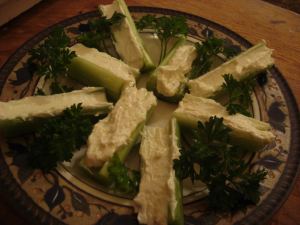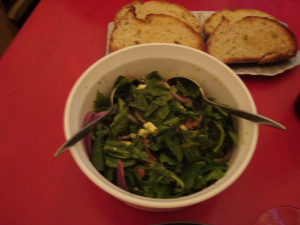 “It’s too late to turn back, here we go. Oooo Portland, oh no.” — The Replacements
“It’s too late to turn back, here we go. Oooo Portland, oh no.” — The Replacements
I hope you’ll forgive my overlong hiatus. During the last week of the Dodgers’s regular season, I got a little obsessive. We went to two games this weekend, and Potts actually constructed a shrine by the radio consisting of various Dodgers paraphernalia we’ve accumulated over the course of our fandom – bobbleheads, plaques, keychains. They won that night and clinched the NL West, which means, of course, that now we can’t take it down.
So, this week, you’re getting two meals instead of one. Both are from cookbooks published by the Junior League of Portland, Oregon, both are excellent work night meals, simple and quick to prepare. However, the two are separated by about four decades of culinary sensibilities. I can’t believe I never thought to do this before, even though I have quite a few pairings of old and new Junior League cookbooks in my collection (and more available to me through the wonderful cookbook collection at the Los Angeles Public Library, one of the best in the nation).
The first meal comes from Cooked to Taste, published in 1954. The book is unique because rather than being a collection of recipes submitted by many League members, all the recipes in Cooked to Taste come from the collection of Harriet Cumming Coe, “a sustaining member, who has long collected recipes and cookbooks, and who has an enviable reputation as an authority on food.” The result is a collection of tried and true recipes from old family cookbooks, friends and relatives, and recipes that Coe herself perfected over the years.
After returning from the Dodgers game this afternoon, I decided that a nice, light little amuse bouche would be just the thing to clear the taste of Dodger Dogs and beer from our palates. And I do have a weakness for horseradish.
Horsefeathers

Horsefeathers
small inside stalks of celery
1 package cream cheese (3 ounces)
2 teaspoons fresh horseradish
rich cream
pinch of salt
Mix the horseradish, cheese, salt, and enough cream to make a stiff paste. Stuff the celery.
Nothing fancy, but a tasty little bite with just a bit of a kick. It might also be nice with some fresh chopped chives sprinkled on top for a garnish.
I realized too late that the “feathers” part of the name comes from the celery leaves on top of the stalks. However, as I’d already chopped those off, I decided that a few sprigs of parsley could be suggestive of feathers if one used one’s imagination.
There were a number of issues with the second recipe that gave me pause. But I remembered a rule I made to myself when I began this project: follow the original recipe as closely as possible, no matter what. If it says to crumble ginger snaps into beef juice, then you do it and you do not ask questions. Who are you to question the Junior League? For the record, I do not endorse the cooking of salmon in cream, nor the baking of cucumbers. But as this is Portland week, I figured I should at least give this salmon dish a try.
Baked Salmon

Baked Salmon
2 1/2 to 3 pound piece fresh salmon
salt, pepper
dash of thyme
1 clove garlic
3 tablespoons butter
1 1/2 cups light cream
1 bay leaf
4 thin slices onion
3 sprigs parsley
2 large cucumbers
Rub the salmon with the mixed salt, pepper, thyme, and garlic. Melt the butter in an earthenware baking dish. Add the salmon and turn it in the dish to coat with the butter. Add the cream, bay leaf, onion and parsley. Peel the cucumbers, cut them into strips and place them around the fish.

Understandably, I had my doubts as to the deliciousness of this preparation.
Bake, covered, in a 350 degree oven for 40 minutes, or until the fish is tender and the center bone can be pulled out easily.
Discard the bay leaf, onion slices, parsley and garlic. Serve in the baking dish.
Long story short, it was fine. I mean, it wasn’t great, and I didn’t like the way the cream coagulated on top of the baked salmon (just scraped it off), and I still have no idea why the recipe called for cucumbers, but it tasted like plain old baked salmon, which was more than I’d dared hope for.
On the other end of the spectrum, the green beans recipe I selected for a side dish was amazing.
Until about two months ago, I was not a fan of green beans, and for this, I blame the 1950s.
For this was the decade which gave us the ubiquitous and uniformly awful green bean casserole, cooked to mush and doused in Campbell’s soup. I loathe the stuff. And whether in casserole form or not, all the green beans I’d eaten in my life had been cooked to a limp, soggy, grayish-green mess. Even if they’d once been fresh, you’d never have known it.
And then, two months ago, I went to a vegan Chinese restaurant where they served sauteed long beans, which were bright green, al dente, studded with garlic, and bursting with flavor. I ate something like five plates of the stuff, and renounced my views on the poor, misunderstood green bean.
Since then, I’ve been scouring my Junior League cookbooks for a green beans recipe, but to my dismay, nearly every one involved canned green beans, which should be eaten by no one. So, when I found this one in, of all things, a cookbooks from the 1950s, I was very excited.
Sauteed String Beans

Sauteed String Beans
2 pounds fresh string beans
boiling salted water
6 tablespoons butter
juice of 1/2 a lemon
salt and pepper, to taste
1 tablespoon finely chopped parsley
1 clove garlic, finely chopped
Cook the beans in the boiling salted water until tender. Drain. Saute the beans in a skillet with the butter, adding salt, pepper, parsley and garlic. Sprinkle the lemon juice over just before serving.
These taste like a million bucks, and Brady even remarked, “You know, I really don’t like green beans, but I like these.”
You will, too.
 Having eaten my fill of Portland, circa 1954, I turned to From Portland’s Palate, published in 1992. While the focus of Cooked to Taste was very much home cooking, Portland four decades later was a city very much aware of Alice Waters, the idea of eating locally and seasonally, and the idea that this kind of food could be elegant, gourmet fare. However, they’ve also not lost sight of their home kitchen roots. In the introduction, the editors write that Portland cooking possesses “a unique blend of cosmopolitan flair and small-city friendliness.”
Having eaten my fill of Portland, circa 1954, I turned to From Portland’s Palate, published in 1992. While the focus of Cooked to Taste was very much home cooking, Portland four decades later was a city very much aware of Alice Waters, the idea of eating locally and seasonally, and the idea that this kind of food could be elegant, gourmet fare. However, they’ve also not lost sight of their home kitchen roots. In the introduction, the editors write that Portland cooking possesses “a unique blend of cosmopolitan flair and small-city friendliness.”
Ever since Phoenix week, when I made a jicama salad with honey mustard dressing, I’ve been very bullish on the idea of making my own salad dressing, and this looked like a nice one.
Spinach Salad with Basil Dressing

Spinach Salad with Basil Dressing (a little blurry)
1 bunch spinach, torn into pieces
1 small avocado, cubed
1/2 small red onion, thinly sliced
4 ounces feta cheese (1/2 cup), crumbled
1/2 cup walnuts or pecans, coarsely chopped
Dressing
2 large garlic cloves, minced
1/4 cup fresh basil leaves (packed) or 2 T. dried basil
1/4 cup red wine vinegar
2 t. granulated sugar
1/2 cup olive oil
1/2 t. freshly ground black pepper
In a large bowl, combine spinach, avocado, onion, feta, and nuts.
Dressing
In a food processor or blender, add garlic and pulse 4 to 5 times. Add basil, pulse to combine, then add vinegar and sugar. With processor running, drizzle in olive oil until emulsified. Season with pepper.
Pour dressing over salad and toss well. Serve immediately.
Note: A mixture of spinach and red leaf lettuce adds festive color. Consider jicama root as an addition to this salad.
This is a terrific salad, and the garlic gives the salad a bold, spicy tang. I lightly toasted the walnuts before adding them to the salad, which added a pleasant warmth as well.
Since autumn, which made a brief appearance two weeks ago, seems to have tentatively returned, I thought this pumpkin soup seemed appropriately savory.
Curried Pumpkin Soup
Ward off the first chill of autumn with this seasonal soup.

Curried Pumpkin Soup
1 large onion, diced
1/4 cup butter (1/2 cube)
1 t. curry powder
2 1/2 cups chicken broth
3 cups canned pumpkin
1/2 t. salt
2 cups half and half
Sour cream
Fresh parsley, coarsely chopped
In a large saucepan over medium heat, saute diced onions in butter until softened. Sprinkle in curry powder. Pour mixture into blender or food processor and puree until smooth. Return to saucepan and add chicken broth, canned pumpkin, salt and half and half. Heat through over medium heat. Do not bring to boil or soup will curdle. Garnish with a dollop of sour cream and chopped parsley flakes.
This soup and salad, served with toasted French bread and a bottle of nice red wine, not only makes for a supremely satisfying, elegant dinner, you can also get the entire thing made in about an hour. I can’t remember the last time I had a meal that felt this put together on a work night. In the future, I might do a combination of half and half and milk to make a lighter, thinner soup, but even as is, it’s silky, surprisingly complex, and absolutely lovely.
Starting next week, I’ll be turning my attentions to the cuisine of the cities which currently have teams engaged in postseason MLB play. Because, let’s face it, that’s where my head is going to be anyway. During last year’s World Series, Brady and I made Philly cheesesteaks for a week, and it was awesome, even though we hate the Phillies and wish them nothing but quick, brutal humiliation at the hands of the Rockies this week.
I also hate the Rockies, just not as much as the Phillies. Come to think of it, I also hate the Yankees and the Red Sox.
Dodgers, Angels, Twins, and Tigers (however that shakes out), Cardinals, they can all live.
Preferably in that order.